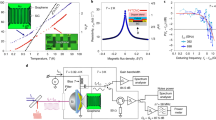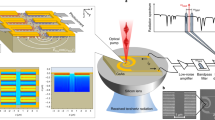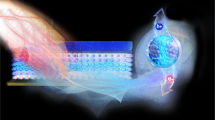Abstract
Room-temperature operation is essential for any optoelectronics technology that aims to provide low-cost, compact systems for widespread applications. A recent technological advance in this direction is bolometric detection for thermal imaging1, which has achieved relatively high sensitivity and video rates (about 60 hertz) at room temperature. However, owing to thermally induced dark current, room-temperature operation is still a great challenge for semiconductor photodetectors targeting the wavelength band between 8 and 12 micrometres2, and all relevant applications, such as imaging, environmental remote sensing and laser-based free-space communication3,4,5, have been realized at low temperatures. For these devices, high sensitivity and high speed have never been compatible with high-temperature operation6,7. Here we show that a long-wavelength (nine micrometres) infrared quantum-well photodetector8 fabricated from a metamaterial made of sub-wavelength metallic resonators9,10,11,12 exhibits strongly enhanced performance with respect to the state of the art up to room temperature. This occurs because the photonic collection area of each resonator is much larger than its electrical area, thus substantially reducing the dark current of the device13. Furthermore, we show that our photonic architecture overcomes intrinsic limitations of the material, such as the drop of the electronic drift velocity with temperature14,15, which constrains conventional geometries at cryogenic operation6. Finally, the reduced physical area of the device and its increased responsivity allow us to take advantage of the intrinsic high-frequency response of the quantum detector7 at room temperature. By mixing the frequencies of two quantum-cascade lasers16 on the detector, which acts as a heterodyne receiver, we have measured a high-frequency signal, above four gigahertz (GHz). Therefore, these wide-band uncooled detectors could benefit technologies such as high-speed (gigabits per second) multichannel coherent data transfer17 and high-precision molecular spectroscopy18.
This is a preview of subscription content, access via your institution
Access options
Access Nature and 54 other Nature Portfolio journals
Get Nature+, our best-value online-access subscription
$29.99 / 30 days
cancel any time
Subscribe to this journal
Receive 51 print issues and online access
$199.00 per year
only $3.90 per issue
Buy this article
- Purchase on Springer Link
- Instant access to full article PDF
Prices may be subject to local taxes which are calculated during checkout




Similar content being viewed by others
References
Wood, R. A. in Infrared Detectors and Emitters: Materials and Devices, Vol. 8 (eds Capper, P . & Elliott, C. T. ) 149–175 (Springer, 2001)
Rogalski, A. Infrared detectors: status and trends. Prog. Quantum Electron. 27, 59–210 (2003)
Gunapala, S. D. & Bandara, S. V. in Semiconductors and Semimetals, Vol. 62 (eds Liu, H. C. & Capasso, F. ) 197–282 (Academic, 2000)
Mizaikoff, B. Mid-IR fiber-optic sensors. Am. Chem. Soc. 75 258A–267A (2003)
Martini, R. & Whittaker, E. A. Quantum cascade laser-based free space optical communications. J. Opt. Fiber Commun. Res. 4, 279–292 (2005)
Henini, M. & Razeghi, M. (eds) Handbook of Infrared Detection Technologies (Elsevier, 2002)
Schneider, H . & Liu, H. C. in Quantum Well Infrared Photodetectors: Physics and Applications 72–75 (Springer, 2007)
Levine, B. F., Choi, K. K., Bethea, C. G., Walker, J. & Malik, R. J. New 10 μm infrared detector using intersubband absorption in resonant tunneling GaAlAs superlattices. Appl. Phys. Lett. 50, 1092–1094 (1987)
Todorov, Y. et al. Optical properties of metal–dielectric–metal microcavities in the THz frequency range. Opt. Express 18, 13886–13907 (2010)
Feuillet-Palma, C., Todorov, Y., Vasanelli, A. & Sirtori, C. Strong near field enhancement in THz nano-antenna arrays. Sci. Rep. 3, 1361 (2013)
Nga Chen, Y. et al. Antenna-coupled microcavities for enhanced infrared photo-detection. Appl. Phys. Lett. 104, 031113 (2014)
Palaferri, D. et al. Patch antenna terahertz photodetectors. Appl. Phys. Lett. 106, 161102 (2015)
Palaferri, D. et al. Ultra-subwavelength resonators for high temperature high performance quantum detectors. New J. Phys. 18, 113016 (2016)
Grundmann, M. in Physics of Semiconductors: An Introduction Including Nanophysics and Applications 191–195 (Springer, 2010)
Howarth, D. J. & Sondheimer, E. H. The theory of electronic conduction in polar semi-conductors. Proc. R. Soc. A 219, 53–74 (1953)
Faist, J. et al. Distributed feedback quantum cascade lasers. Appl. Phys. Lett. 70, 2670–2672 (1997)
Corrigan, P., Martini, R., Whittaker, E. A. & Bethea, C. Quantum cascade lasers and the Kruse model in free space optical communication. Opt. Express 17, 4355–4359 (2009)
Argence, B. et al. Quantum cascade laser frequency stabilization at the sub-Hz level. Nat. Photon. 9, 456–460 (2015)
Vodopyanov, K. L., Chazapis, V., Phillips, C. C., Sung, B. & Harris, J. S. Jr. Intersubband absorption saturation study of narrow III–V multiple quantum wells in the spectral range. Semicond. Sci. Technol. 12, 708–714 (1997)
Theocharous, E., Ishii, J. & Fox, N. P. A comparison of the performance of a photovoltaic HgCdTe detector with that of large area single pixel QWIPs for infrared radiometric applications. Infrared Phys. Technol. 46, 309–322 (2005)
Stangier, T., Sonnabend, G. & Sornig, M. Compact setup of a tunable heterodyne spectrometer for infrared observations of atmospheric trace-gases. Remote Sens. 5, 3397–3414 (2013)
Grant, P. D., Dudek, R., Buchanan, M. & Liu, H. C. Room-temperature heterodyne detection up to 110 GHz with a quantum-well infrared photodetector. IEEE Photonics Technol. Lett. 18, 2218–2220 (2006)
Schneider, H., Schönbein, C., Bihlmann, G., Van Son, P. & Sigg, H. High-speed infrared detection by uncooled photovoltaic quantum well infrared photodetectors. Appl. Phys. Lett. 70, 1602–1604 (1997)
Graf, M., Hoyler, N., Giovannini, M., Faist, J. & Hofstetter, D. InP-based quantum cascade detectors in the mid-infrared. Appl. Phys. Lett. 88, 241118 (2006)
Hofstetter, D. et al. Mid-infrared quantum cascade detectors for applications in spectroscopy and pyrometry. Appl. Phys. B 100, 313–320 (2010)
Hinds, S. et al. Near-room-temperature mid-infrared quantum well photodetector. Adv. Mater. 23, 5536–5539 (2011)
Piotrowski, J., Galus, W. & Grudzien, M. Near room-temperature IR photo-detectors. Infrared Phys. 31, 1–48 (1991)
Liu, H. C. Photoconductive gain mechanism of quantum-well intersubband infrared detectors. Appl. Phys. Lett. 60, 1507–1509 (1992)
Hava, S. & Auslender, M. Velocity-field relation in GaAlAs versus alloy composition. J. Appl. Phys. 73, 7431–7434 (1993)
Gensty, T., Elsäßer, W. & Mann, C. Intensity noise properties of quantum cascade lasers. Opt. Express 13, 2032–2039 (2005)
Villares, G., Hugi, A., Blaser, S. & Faist, J. Dual-comb spectroscopy based on quantum-cascade-laser frequency combs. Nat. Commun. 5, 5192 (2014)
Sze, S. M. & Kwok, Ng . Physics of Semiconductor Devices (Wiley, 2011)
Acknowledgements
We acknowledge financial support from the FP7 ITN NOTEDEV project (grant number 607521), the ERC grant ADEQUATE, the French National Research Agency (ANR-16-CE24-0020 Project “hoUDINi”) and the EPSRC (UK) projects COTS and HYPERTERAHERTZ (EP/J017671/1, EP/P021859/1). E.H.L. and A.G.D. acknowledge support from the Royal Society and the Wolfson Foundation and thank L. Chen for support with device processing.
Author information
Authors and Affiliations
Contributions
D.P., Y.T. and C.S. conceived the experiments, designed the QWIP structure, analysed the data and wrote the manuscript. D.P. fabricated the QWIP devices and performed measurements and data analysis, together with A.B. A.M. and D.G. helped with the heterodyne measurements. A.C. calibrated the blackbody for the responsivity measurements and helped with the characterization of the mesa device. A.V. helped with data analysis. L.L., A.G.D. and E.H.L. grew the QWIP structure and provided the wafer-bonding for the double-metal processing. F.K., M.B. and J.F. provided the DFB QCLs for the heterodyne experiment. All the work was supervised by C.S.
Corresponding author
Ethics declarations
Competing interests
The authors declare no competing financial interests.
Additional information
Reviewer Information Nature thanks H. Schneider and the other anonymous reviewer(s) for their contribution to the peer review of this work.
Publisher's note: Springer Nature remains neutral with regard to jurisdictional claims in published maps and institutional affiliations.
Extended data figures and tables
Extended Data Figure 1 Global view of the device.
Scanning electron microscope image of mid-infrared QWIP structure embedded into a 50 × 50 μm2 array of patch resonators. The top TiAu contact is evaporated onto an 800-nm-thick Si3N4 insulating layer.
Extended Data Figure 2 Polarization dependence of the photoresponse.
a, Finite-element simulation of the Ez component of the electric field coupled with the patch-cavity QWIP for the TM100 and the TM010 modes. The colour scale represents the amplitude of the electric field and ranges from the absolute maximum (red) to the maximum amplitude in the opposite field direction (blue). b, Polar graph of the cavity photocurrent peak as a function of the wire-grid polarization angle. The photocurrent is normalized by its maximum value, at 0°. The open circles are the results for the cavity array, where the 90° direction corresponds to the connecting wires. The open squares are the results for the mesa geometry, where the 0° direction corresponds to the growth direction of the quantum wells.
Extended Data Figure 3 Mesa and cavity-array detector characteristics.
a, Responsivity of the mesa and the s = 1.35 μm antenna-coupled devices as a function of applied voltage. The temperature (in kelvin) of the QWIP is indicated for each measured curve. b, Specific detectivity for the mesa and the microcavity devices as a function of the applied bias at different temperatures.
Extended Data Figure 4 Spectral characteristics of the two lasers and the QWIP detector.
a, Emission spectra of the QCLs (QCLLO and QCLS), compared with the room-temperature response of the microcavity QWIP. b, Magnification of the spectrum of a, showing the two distinct QCL emission lines. QCLLO was operated at 330 mA and a stable temperature of 293 K, and QCLS was operated at 280 mA and a stable temperature of 254 K.
Rights and permissions
About this article
Cite this article
Palaferri, D., Todorov, Y., Bigioli, A. et al. Room-temperature nine-µm-wavelength photodetectors and GHz-frequency heterodyne receivers. Nature 556, 85–88 (2018). https://doi.org/10.1038/nature25790
Received:
Accepted:
Published:
Issue Date:
DOI: https://doi.org/10.1038/nature25790
This article is cited by
-
Synergistic-potential engineering enables high-efficiency graphene photodetectors for near- to mid-infrared light
Nature Communications (2024)
-
High-performance Si/VO2-nanorod heterojunction photodetector based on photothermoelectric effect for detecting human radiation
Rare Metals (2024)
-
Broadband long-wave infrared high-absorption of active materials through hybrid plasmonic resonance modes
Discover Nano (2023)
-
Far-infrared transparent conductors
Light: Science & Applications (2023)
-
Long-wave infrared photothermoelectric detectors with ultrahigh polarization sensitivity
Nature Communications (2023)
Comments
By submitting a comment you agree to abide by our Terms and Community Guidelines. If you find something abusive or that does not comply with our terms or guidelines please flag it as inappropriate.



